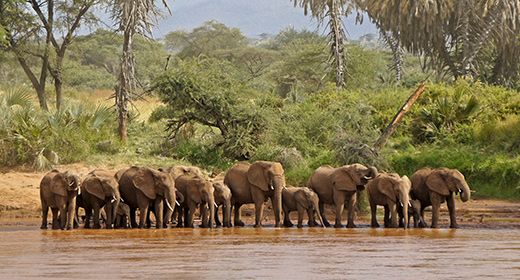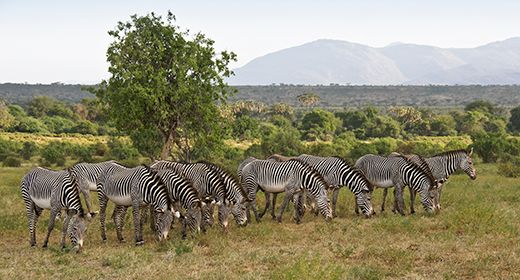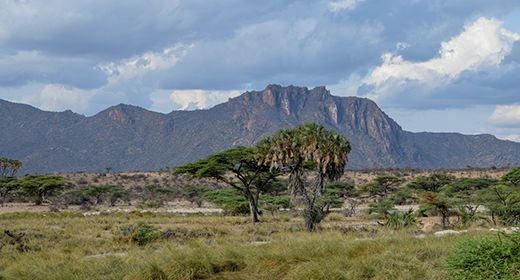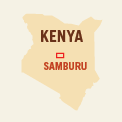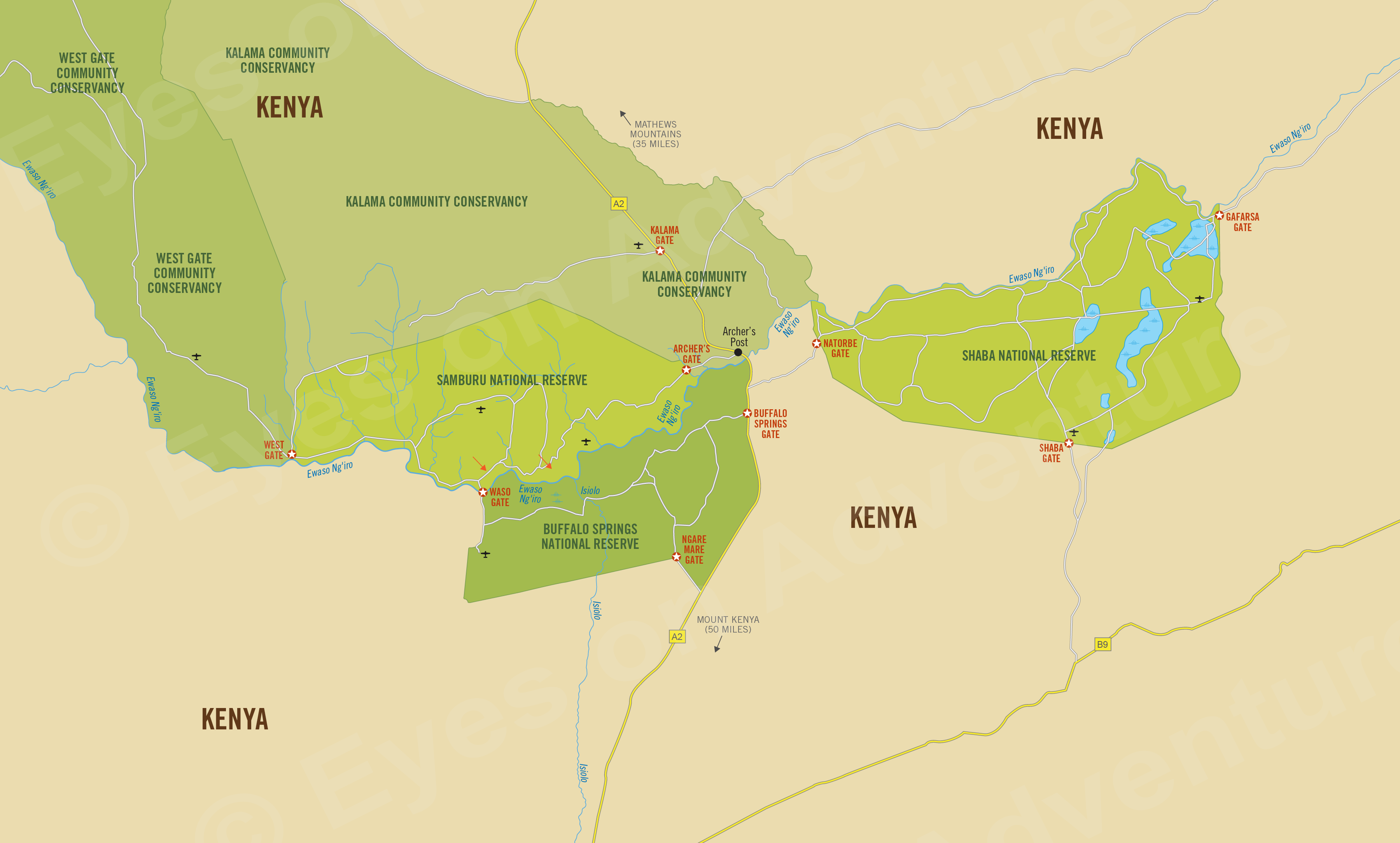Samburu
(incl. Samburu National Reserve, Buffalo Springs, Shaba, West Gate, Kalama)
Region Links: Amboseli & Chyulu Hills, East Coast Kenya, Great Migration, Laikipia, Masai Mara, Nairobi, Rift Valley & Central Highlands, Samburu, Tsavo
Highlights
- Great diversity of dry-land species not easily seen elsewhere
- The Ewaso Ng'iro river brings year-round life to this otherwise arid region
- Experience the welcoming Samburu people and their culture
- These northern frontier reserves offer a remote wilderness experience
EOA Recommends: Joy's Camp, Larsen's Camp, Sasaab
Based around the life-giving Ewaso Ng'iro River in the hot and arid low-lying lands north of Mount Kenya, the reserves of Samburu, Buffalo Springs and Shaba are home to some of Kenya's most diverse wildlife.
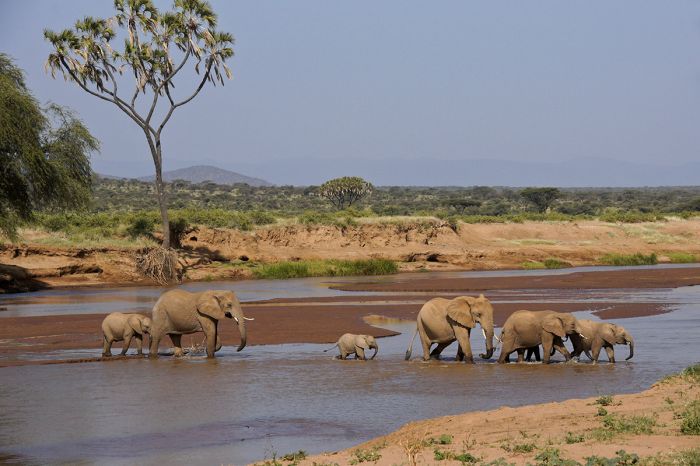
Elephants crossing the Ewaso Ng'iro river in Samburu.
The Reserves of Samburu and Buffalo Springs share a border on either side of the near-permanent Ewaso Ng'iro River and the Shaba Reserve, which also borders the same river, is only a short distance to the east. The combined reserves cover 170 square miles (440 square kms) and offer the country's most remote game viewing experience alongside the tribal culture of the local Samburu people.
The wildlife in the Samburu region is best viewed along the river during the dry season, but the parks are home to year-round wildlife, including predators, a host of herbivores and birdlife.
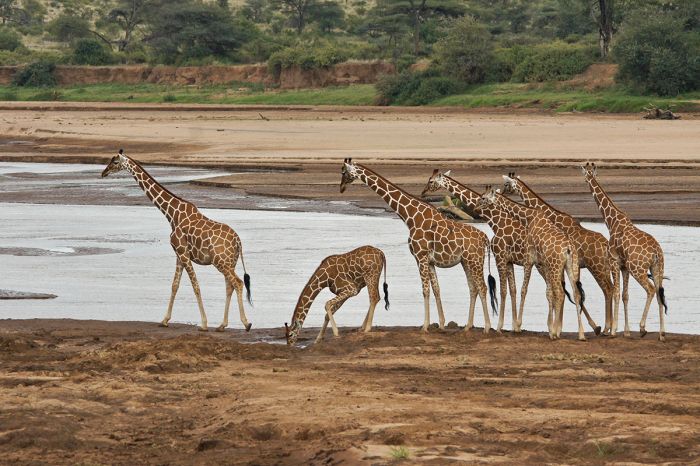
Reticulated giraffes along the Ewaso Ng'iro river in Samburu.
The reserves here form the most important tourist destination in the north of Kenya, with numerous camps and lodges and a well developed game drive road network. For those looking to get away from the crowds of Kenya's more popular parks, this region is well worth a look.
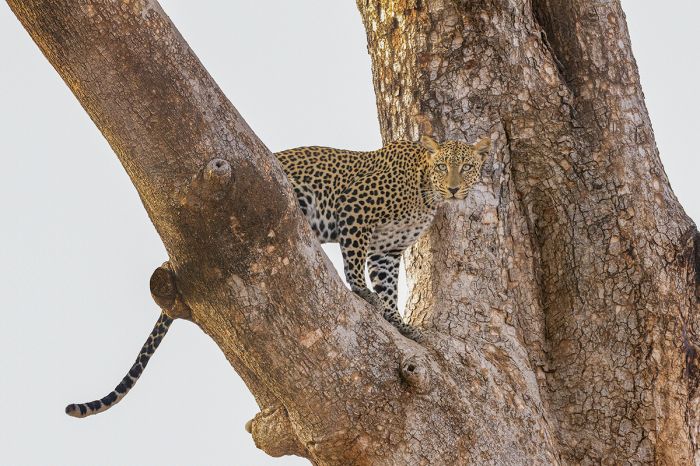
A leopard in Samburu, Kenya.
Read More...
Buffalo Springs, Kalama, Samburu People, Samburu Reserve, Shaba, West Gate
Samburu people
The history and origins of the Samburu people is not entirely known, but oral records passed down indicate that they migrated south from Sudan or possibly Egypt into Kenya. They are closely related to the Maasai people, who refer to the Samburu as the "Butterfly People". The Maasai continued migrating further south into southern Kenya and northern Tanzania, while the Samburu remained behind in northern Kenya. The 'Samburu' language is a dialect of 'Maa', the language of the Maasai.
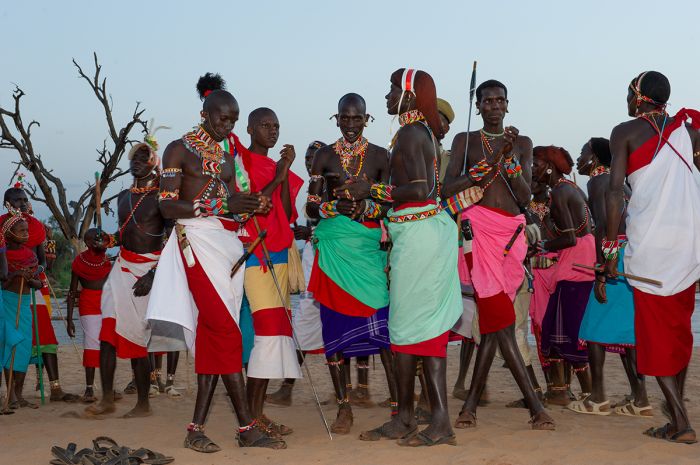
Samburu 'moran' warriors. (Copyright © James Weis)
Like the Maasai, the Samburu are a highly pastoral tribe, who raise cattle, sheep, and goats, but placing the utmost importance on their herds of cattle, which impart status and wealth on the owner. They also hold the same belief as the Maasai, that all of the Earth's cattle rightfully belong to them and, as such, cattle raiding has historically been undertaken by the tribe's warriors.
The Samburu have managed to retain their culture and traditions and visiting the region may include a visit to a Samburu 'Manyatta', which will offer rewarding insights into the day-to-day lives of this rich and colorful tribe.
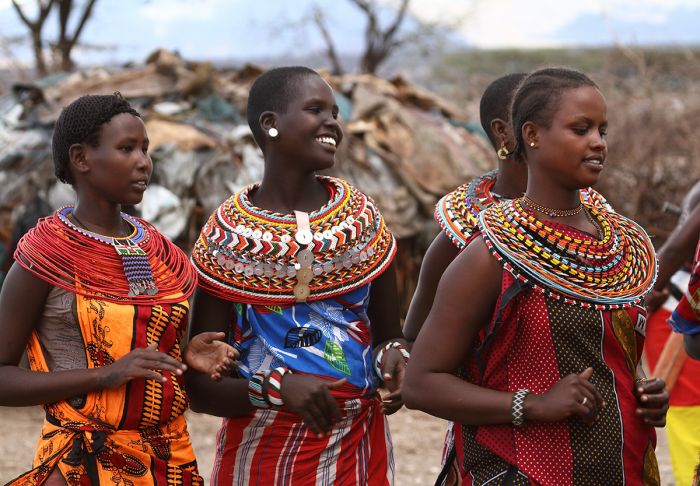
Samburu women in their traditional dress.
The Samburu have managed to hold on to much of their traditional way of living; more so than the Maasai. Most of the land here is now protected and many of the lodges are run as community development projects that are jointly owned by the Samburu people that live nearby.
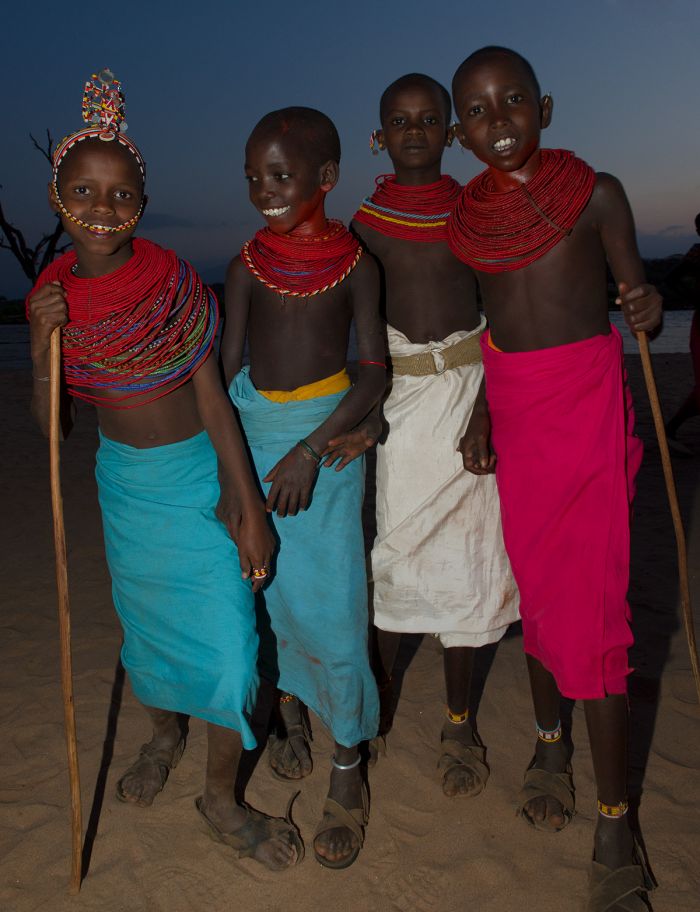
Samburu children. (Copyright © James Weis)
Samburu and Buffalo Springs reserves
The Samburu and Buffalo Springs Reserves were given protected status as a single reserve in 1948 and subsequently divided into two reserves in 1963. The Ewaso Ng'iro River, which originates from glaciers and precipitation atop Mount Kenya to the south, is the shared border between the two reserves, with Samburu north of the river and Buffalo Springs to the south.
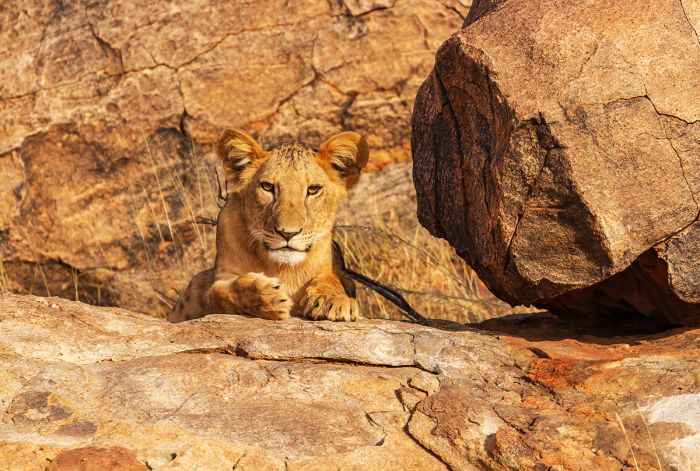
Young lion In Samburu National Reserve.
Wildlife numbers in arid ecosystems like Samburu are especially dependent upon the rains and the resultant availability of food and, as such, game viewing in the region can sometimes be hit or miss. Commonly seen animals here include lion, cheetah, leopard, elephants and buffalo. Both species of rhino, once prevalent in good numbers, are no longer found here. The riverside drive tracks are the best place to look for wildlife.
There are various uncommon and dry-land species that live in Samburu/Buffalo Springs, including the reticulated giraffe, Grevy's zebra, gerenuk antelope, Beisa oryx, lesser kudu, local races of Grant's gazelle and impala, and Guenther's dik-dik. Bird life in the region is good and includes numerous dry-land species not easily seen elsewhere in Kenya, such as Somali ostrich, Abyssinian ground-hornbill and vulturine guineafowl.
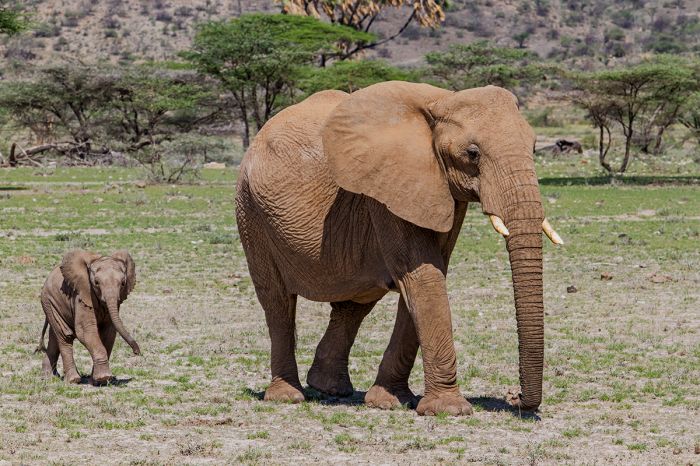
Elephant and small calf in Buffalo Springs.
The Samburu Reserve is primarily made up of rocky soils, with shrubby acacia woodlands. The river on its south border provides a near-permanent source of water for the animals and the forested cover along its banks usually provides good year-round game viewing.
The Buffalo Springs Reserve on the southern banks of the river has a more open environment, with clay soils and grasslands interspersed with acacia-scrub woodland. The reserve is named for the few spring-fed marshy areas also present here and providing an excellent spot to look for wildlife.
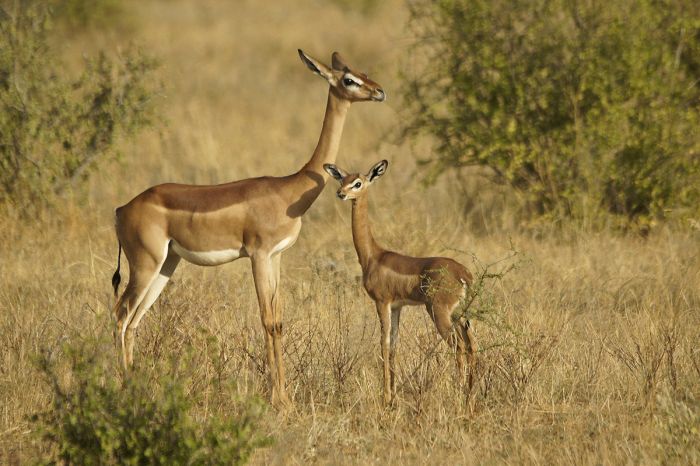
Gerenuk antelope with calf in Samburu.
Shaba
The Shaba National Reserve is located 3 miles (5 kms) east of Samburu and Buffalo Springs and is bordered on its north by the Ewaso Ng'iro River. Shaba was created in 1974 and, of the threes reserves, is by far the least well known and visited. As a result, Shaba has a more wild and remote feel to it than the other two reserves.
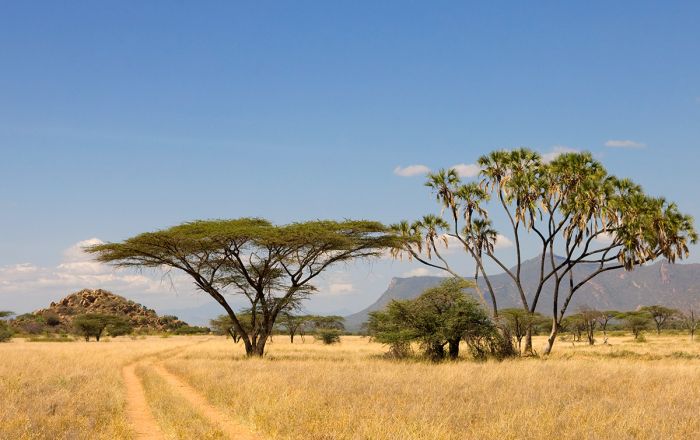
Shaba landscape with acacia and doum palm.
Wildlife in Shaba is similar to that in Samburu/Buffalo Springs, although it seems drier and less vegetated here. The reserve hosts good populations of elephant, giraffe, Grevy's zebra, gerenuk, lion, and jackal. Shaba is by far the least visited of the three reserves.
Joy's Camp, one of the few permanent tourist camps in Shaba, is named for Joy Adamson, who used the location for a campsite in the 1960's. Her well-known book Born Free and the Academy Award-winning movie of the same name, were about her (and husband George's) experiences in the 1950's raising a lion cub named 'Elsa' in nearby Meru National Park. Joy was murdered at the age of 69 at her camp in Shaba. She is buried next to her beloved Elsa in Meru.
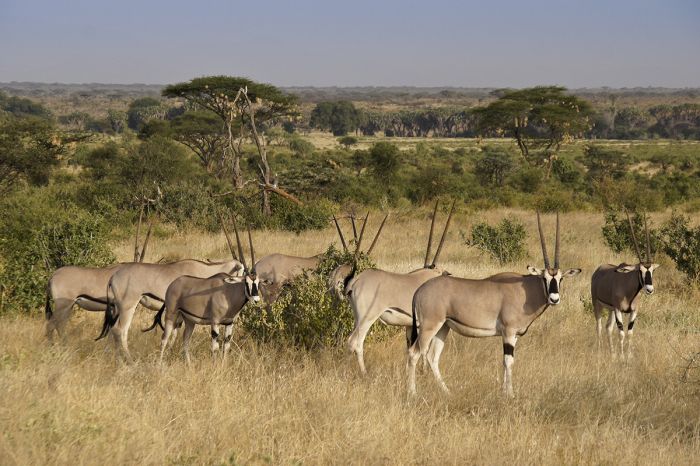
Beisa Oryx in Shaba Reserve.
In more recent times, Shaba was the location for the TV show Survivor Africa and was where a lioness garnered world attention when she adopted and cared for a string of Beisa oryx calves over a two-year period.
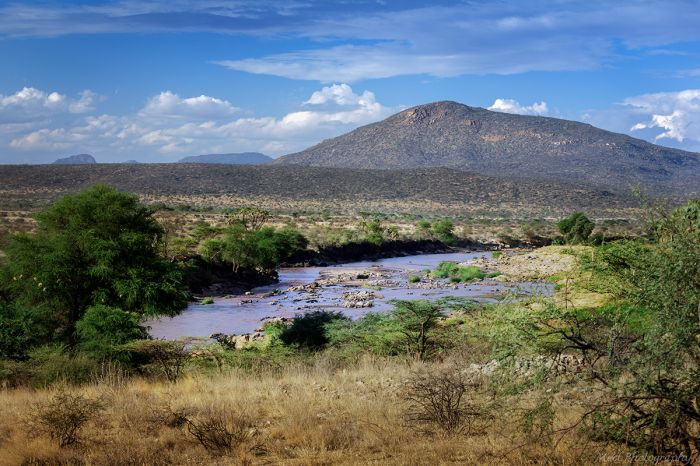
The Ewaso Ng'iro River flowing through the Samburu region.
Kalama Conservancy
Created in 2002, the Kalama Community Conservancy covers 191 square miles (496 sq kms) of land directly north of the Samburu Reserve. Kalama combines pastoralism and tourism for about 10 000 local Samburu people living here. The landscape is predominantly acacia grassland with some dry, upland/montane forest.
Kalama's land is very dry, but still offers good numbers of wildlife including elephant, reticulated giraffe, Beisa oryx, Grevy's zebra, gerenuk, lesser kudu, and greater kudu. Predators include lion, leopard, cheetah, and African wild dog. Saruni operates a very good lodge in Kalama and guests will feel as if they have the conservancy all to themselves. Trips to the other reserves are also possible.
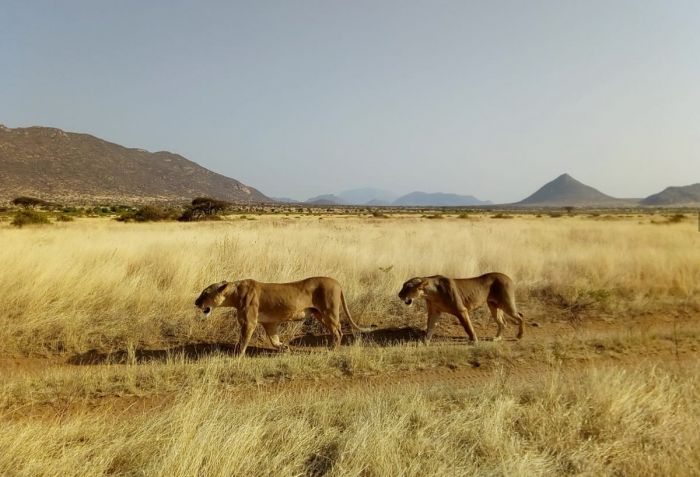
Lions in the Kalama Conservancy. (Copyright © Saruni Samburu)
West Gate Conservancy
West of Kalama and the Samburu Reserve lies the 140-square-mile (363-sq-km) West Gate Community Conservancy. West Gate was created in 2004 and, like Kalama, provides tourism revenue for the local Samburu people, which number around 4 500.
West Gate's landscape is hilly and dry, covered primarily by acacia scrub, but the Ewaso Ng'iro River traverses its western boundary, attracting plenty of animals. Sasaab Lodge is the only accommodation and it is spectacular. Wildlife includes elephant, eland, Beisa oryx, reticulated giraffe, gerenuk, Grevy's zebra, lion, leopard, cheetah, and African wild dog.
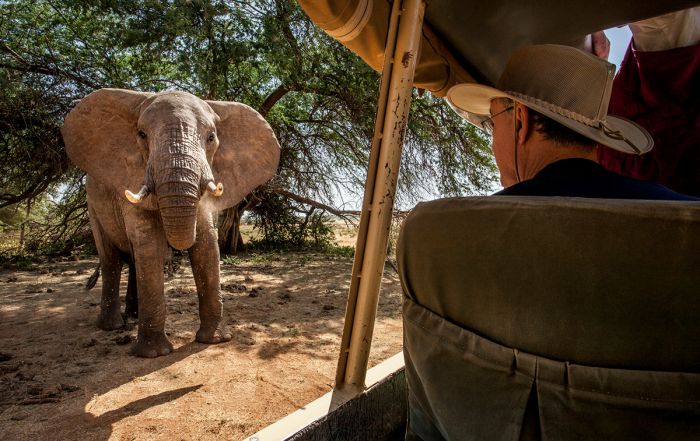
A close encounter with an elephant in West Gate Conservancy. (Copyright © Sasaab)
Read More...
Buffalo Springs, Kalama, Samburu People, Samburu Reserve, Shaba, West Gate
Great Good Fair Poor
- Jan
- Feb
- Mar
- Apr
- May
- Jun
- Jul
- Aug
- Sep
- Oct
- Nov
- Dec
The Samburu region is a year-round destination, but is best visited during the driest months (June thru October), when wildlife viewing peaks, especially along the banks of the Ewaso Ng'iro river, which flows through all three reserves.
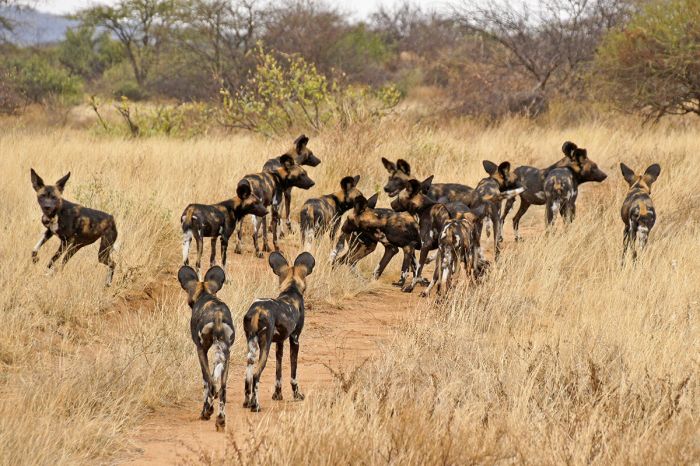
African wild dogs in Samburu.
The short rains fall for about a month during November-December and the longer, heavier rains occur from April thru May. Road conditions can be poor during and just after the rains, especially in April and May, and wildlife disperses widely when water and vegetation availability becomes better away from the river.
June through September and January/February are typically excellent for game viewing. April is the wettest month, with heavy downpours likely.
The climate in Samburu is warm year-round, as it lies just north of the equator. Daytime temperatures reach the upper-80's°F to 90°F (low 30's°C) during the day, but evenings can be cool (mid-60's°F/15°C).
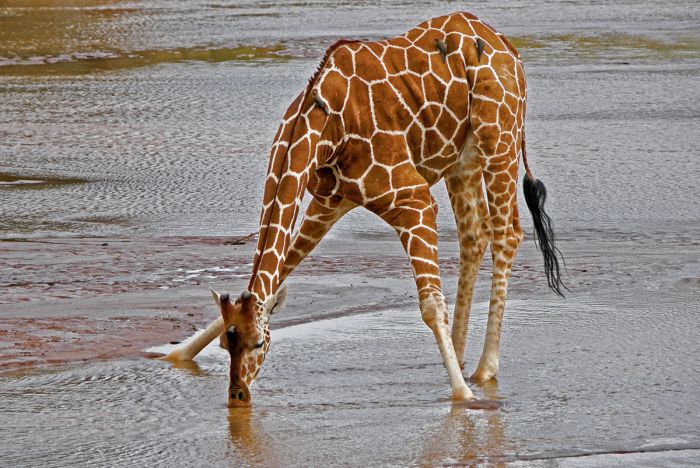
Reticulated giraffe in the Ewaso Ng'iro river.




